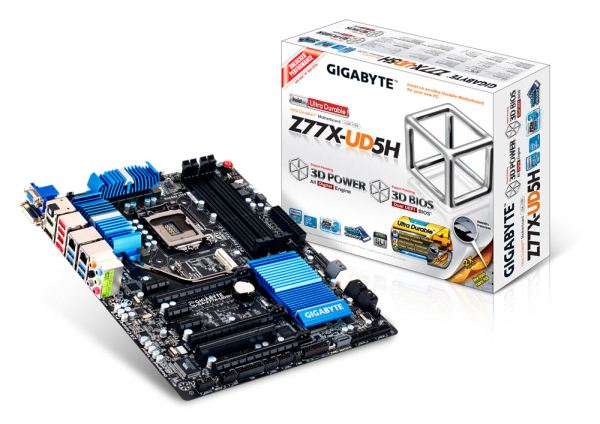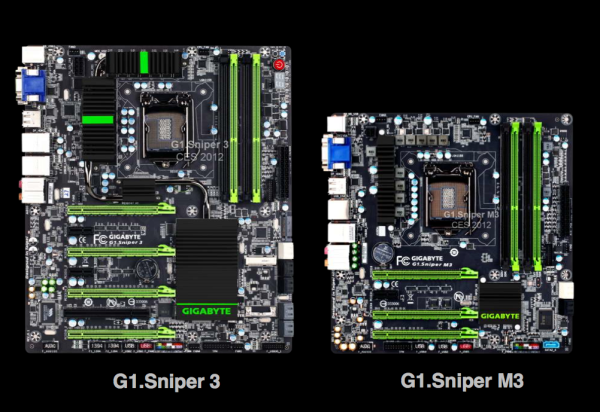A Brief Look at Some Upcoming 7-Series Motherboards
by Ian Cutress on March 9, 2012 5:00 PM EST- Posted in
- Motherboards
- Intel
- H77
- Z77
Gigabyte
Whenever a new chipset comes out, Gigabyte tend to do one of two things – either release a few boards to cover particular price points (usually models from UD3 to UD7), or release more than 10 or even 20+ products for the chipset. This latter method of attacking the market could perhaps overwhelm users into deciding which model to purchase, or that reviews could end up with so many boards to review it is hard to decipher which are the important ones. Nevertheless, Gigabyte for the 7-series launch has decided to attack the market with the latter, in the following models:
Gigabyte G1.Sniper 3
Gigabyte G1.Sniper M3
Gigabyte GA-Z77X-UD5H Wifi
Gigabyte GA-Z77X-UD5H
Gigabyte GA-Z77X-UD3H Wifi
Gigabyte GA-Z77X-UD3H
Gigabyte GA-Z77X-D3H
Gigabyte GA-Z77-D3H
Gigabyte GA-Z77-DS3H
Gigabyte GA-Z77MX-D3H
Gigabyte GA-Z77M-D3H
Gigabyte GA-H77-DS3H
Gigabyte GA-H77M-D3H
Gigabyte GA-B75M-D3H
Gigabyte GA-B75M-D3V
‘D’ means ‘All solid capacitor design’
‘U’ means ‘Double copper PCB design’
My guess is that this list is by no means complete, exhaustive or final (and perhaps includes models for sale in other parts of the world). No doubt we will see a UD4/UD4H, all the way up to UD7 as well. Gigabyte does have a microsite dedicated to their 7-series products, which does provide an informative list of what should be on offer.
The main features Gigabyte is going to be advertising with their 7-series launch is the almost ubiquitous placing of mSATA connectors on most of their boards, and that the UD3 and above boards come with wifi cards.
Gigabyte GA-Z77X-UD5H
Almost at the top of Gigabyte’s range at release is the GA-Z77X-UD5H. We see that the placement of the mSATA port is just below the CPU, which in the grand scheme of things should be ok as long as the user never wants to remove it (I can just imagine it being relatively stressful to take it out when a system is built and in a case). Also, all the boards in the range have both D-Sub and DVI outputs on the IO, which means on some models that they take up space for any PS/2 ports. This is despite the UD5H still sporting a PCI slot for legacy, even if it is taken up if a second dual slot GPU is used. As always, all Gigabyte models should support TPM, and in the case of the UD5, we have extra SATA ports and dual USB 3.0 headers onboard – all of which would be obscured by a full length third GPU.
G1.Sniper 3 and G1.Sniper M3
If we go back all the way to CES this year, Anand caught glimpse of the G1.Sniper series that Gigabyte had on display:
Given what we know about the Gigabyte range, we have some features to point out – if you want mSATA, it looks like you have to invest in a full size ATX style board. Unfortunately, that also means investing in a board that uses a PLX chip to give 4-way x8 performance for multi-GPU setups. Both boards seem to have specialized capacitors to deal with their audio solutions, which on the Gigabyte microsite states is the Creative Sound Core 3D – which is a step in a positive direction from normal Realtek audio solutions.


















55 Comments
View All Comments
fatpenguin - Friday, March 9, 2012 - link
I was very excited to find that Ivy Bridge is supposed to support up to 3 Display Port outputs natively, since it would eliminate any need for an external graphics card (for me personally). Have you seen any vendors offer this on any current 7-series motherboards?IlllI - Friday, March 9, 2012 - link
you guys should do some review with m-itx motherboards.Knifeshade - Friday, March 9, 2012 - link
I think this is one of the most interesting boards to come out of CeBIT '12. For people who don't need so much expansion slots, they're moving to smaller platforms and this mini ITX board really feels like it's got everything its older siblings have but in a much smaller package. I hope you guys can get one in to have a look over.James5mith - Friday, March 9, 2012 - link
Why aren't more companies putting out products with displayport? It's a great interface, and both Dell and HP have adapted to it wholeheartedly. I personally can't wait until the industry gives up VGA and DVi in favor of it.lbeyak - Saturday, March 10, 2012 - link
High end Z77 boards. I like the look of most of the Asus boards (especially the Sabertooth, 5 year warranty /drools).Reviews on boards with dual NICs would be nice as well.
Integrated Wi-Fi / Bluetooth is interesting to me as well, and I like that they are included on some boards.
Jumpman23 - Saturday, March 10, 2012 - link
Why can't all the usb ports be of the 3.0 flavor? Is it a cost issue? I would assume that usb ports are a fairly small portion of the overall cost for these manufacturers so why not make them all 3.0?IanCutress - Saturday, March 10, 2012 - link
Primarily, it is cost - Z77 gets a couple of USB 3.0 from the chipset, then the rest is controllers. Each controller comes at a cost (I don't know how much, but with markup, probably $5 a piece perhaps[?]), which then gets passed on.Personally, I like to have two or three USB 2.0. When I install an OS for a review, it's via a USB stick - the install package doesn't have a USB 3.0 driver installed, so it can't detect itself when it is loaded (or won't detect my mouse or keyboard). Odd I know, but it means I have to dig out an OS disk if a board goes for solely USB 3.0.
repoman27 - Sunday, March 11, 2012 - link
There are plenty of USB devices (most of the ones in currently in existence, actually) that will never benefit from USB 3.0's additional capabilities. While I agree that it would be simpler for the end user if all the ports were the same, the 7-series chipsets provide 4x USB 3.0 ports and 10x USB 2.0. Since you get the 2.0 ports for free, why not use them?I actually believe it's more of a bandwidth problem than a straight cost issue for Ivy Bridge. (I was under the impression that the Renesas μPD720201 4-port controllers only run about $3 these days.) However, if you were to make all 6 of the SATA ports 6 Gbps and all 14 of the USB ports SuperSpeed on a 7-series motherboard, you'd be adding an additional ~26 Gbps of potential I/O to a southbridge that's only got a 20 Gbps DMI connecting it to the CPU.
Dr. Mobius - Saturday, March 10, 2012 - link
I would really like to see EVGA's line up.Breach1337 - Saturday, March 10, 2012 - link
Great, I personally would love to get the Asus Z77 Sabertooth, but I'm still confused by these PCIe specs? AFAIK, IB has only 16 PCI-E lanes (although they are 3.0 lanes). So if the boards say:2 x PCIe 3.0/2.0 x16 (x16 or dual x8) *2
1 x PCIe 2.0 x16 (x4 mode, black) *3
3 x PCIe 2.0 x1
And I have two PCIe 3.0 cards running x8 SLI where would the extra lanes come for the rest of the stuff - all these PCIe 2.0 slots? Say, if I plug in a 3rd card - my Creative PCI-e 2.0 x1 card would that hurt the 2 x8 SLI's performance?